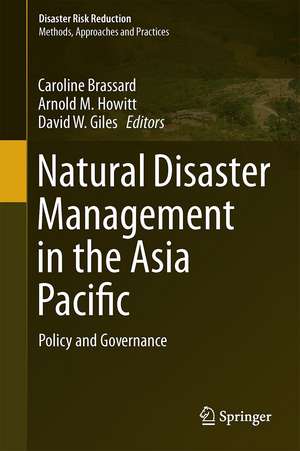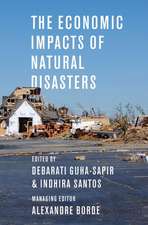Natural Disaster Management in the Asia-Pacific: Policy and Governance: Disaster Risk Reduction
Editat de Caroline Brassard, David W. Giles, Arnold M. Howitten Limba Engleză Hardback – 3 dec 2014
| Toate formatele și edițiile | Preț | Express |
|---|---|---|
| Paperback (1) | 637.13 lei 6-8 săpt. | |
| Springer – 23 aug 2016 | 637.13 lei 6-8 săpt. | |
| Hardback (1) | 643.34 lei 6-8 săpt. | |
| Springer – 3 dec 2014 | 643.34 lei 6-8 săpt. |
Din seria Disaster Risk Reduction
- 18%
 Preț: 796.61 lei
Preț: 796.61 lei -
 Preț: 394.30 lei
Preț: 394.30 lei - 18%
 Preț: 790.46 lei
Preț: 790.46 lei - 15%
 Preț: 654.12 lei
Preț: 654.12 lei - 18%
 Preț: 967.08 lei
Preț: 967.08 lei - 24%
 Preț: 640.30 lei
Preț: 640.30 lei - 18%
 Preț: 1009.16 lei
Preț: 1009.16 lei - 18%
 Preț: 890.54 lei
Preț: 890.54 lei - 18%
 Preț: 942.94 lei
Preț: 942.94 lei - 15%
 Preț: 646.30 lei
Preț: 646.30 lei - 18%
 Preț: 782.24 lei
Preț: 782.24 lei - 18%
 Preț: 898.75 lei
Preț: 898.75 lei - 18%
 Preț: 956.33 lei
Preț: 956.33 lei - 18%
 Preț: 947.50 lei
Preț: 947.50 lei - 24%
 Preț: 921.08 lei
Preț: 921.08 lei - 18%
 Preț: 951.91 lei
Preț: 951.91 lei - 18%
 Preț: 894.97 lei
Preț: 894.97 lei - 15%
 Preț: 641.85 lei
Preț: 641.85 lei - 24%
 Preț: 639.88 lei
Preț: 639.88 lei - 18%
 Preț: 790.14 lei
Preț: 790.14 lei - 18%
 Preț: 729.18 lei
Preț: 729.18 lei - 18%
 Preț: 784.13 lei
Preț: 784.13 lei - 18%
 Preț: 783.50 lei
Preț: 783.50 lei - 18%
 Preț: 784.48 lei
Preț: 784.48 lei - 24%
 Preț: 699.00 lei
Preț: 699.00 lei - 15%
 Preț: 642.18 lei
Preț: 642.18 lei - 15%
 Preț: 651.51 lei
Preț: 651.51 lei - 18%
 Preț: 943.57 lei
Preț: 943.57 lei - 15%
 Preț: 649.54 lei
Preț: 649.54 lei - 24%
 Preț: 690.45 lei
Preț: 690.45 lei - 24%
 Preț: 899.55 lei
Preț: 899.55 lei - 18%
 Preț: 962.27 lei
Preț: 962.27 lei - 15%
 Preț: 652.17 lei
Preț: 652.17 lei - 15%
 Preț: 646.75 lei
Preț: 646.75 lei - 20%
 Preț: 587.30 lei
Preț: 587.30 lei - 15%
 Preț: 647.40 lei
Preț: 647.40 lei - 18%
 Preț: 957.75 lei
Preț: 957.75 lei
Preț: 643.34 lei
Preț vechi: 756.86 lei
-15% Nou
Puncte Express: 965
Preț estimativ în valută:
123.12€ • 133.69$ • 103.42£
123.12€ • 133.69$ • 103.42£
Carte tipărită la comandă
Livrare economică 22 aprilie-06 mai
Preluare comenzi: 021 569.72.76
Specificații
ISBN-13: 9784431551560
ISBN-10: 4431551565
Pagini: 250
Ilustrații: XXIV, 203 p. 21 illus., 16 illus. in color.
Dimensiuni: 155 x 235 x 15 mm
Greutate: 0.5 kg
Ediția:2015
Editura: Springer
Colecția Springer
Seria Disaster Risk Reduction
Locul publicării:Tokyo, Japan
ISBN-10: 4431551565
Pagini: 250
Ilustrații: XXIV, 203 p. 21 illus., 16 illus. in color.
Dimensiuni: 155 x 235 x 15 mm
Greutate: 0.5 kg
Ediția:2015
Editura: Springer
Colecția Springer
Seria Disaster Risk Reduction
Locul publicării:Tokyo, Japan
Public țintă
ResearchCuprins
Confronting Disaster: Recent Lessons from the Asia-Pacific.- Localising the Humanitarian Toolkit: Lessons from Recent Philippines Disasters.- Muhammadiyah and Disaster Response: Innovation and Change in Humanitarian Assistance.- The Impact of the Indian Ocean Tsunami on Maldives.- Collaboration in Emergency Response in China: Evolution from the Wenchuan Earthquake, May 12, 2008 to the Lushan Earthquake, April 20, 2013.- “One in Trouble, All to Help”: The Paired Assistance Program to Disaster-Affected Areas in China.- Collaborative Manpower Support for Restoring Hope in the Aftermath of the March 11 Disasters in Japan.- Communities at the Heart of Recovery: Reflections on the Government-Community Partnership for Recovery after the 2009 Black Saturday Bushfires in Victoria, Australia.- Disaster, Mental Health, and Community Resilience: Lessons from the Field in Aceh Province, Indonesia.- Regional Business Continuity Management through Public-Private Partnerships in Japan.- The Rise of Disaster Risk Insurance and Derivatives.- Building the Urban Community Disaster Relief System in China.
Recenzii
“The book Natural Disaster Management in theAsia-Pacific presents a synopsis of contemporary risk-management thinking inthe Asia-Pacific. … Natural Disaster Management in the Asia-Pacific is wellorganized, concise and easy to navigate. … this book will be of interest tothose involved in disaster risk-management activities throughout theAsia-Pacific.” (Thomas W. Haase, Natural Hazards Observer, Vol. XL (1),September, 2015)
Textul de pe ultima copertă
The Asia-Pacific region is one of the most vulnerable to a variety of natural and manmade hazards. This edited book productively brings together scholars and senior public officials having direct experience in dealing with or researching on recent major natural disasters in the Asia-Pacific. The chapters focus on disaster preparedness and management, including pre-event planning and mitigation, crisis leadership and emergency response, and disaster recovery. Specific events discussed in this book include a broad spectrum of disasters such as tropical storms and typhoons in the Philippines; earthquakes in China; tsunamis in Indonesia, Japan, and Maldives; and bushfires in Australia. The book aims to generate discussions about improved risk reduction strategies throughout the region. It seeks to provide a comparative perspective across countries to draw lessons from three perspectives: public policy, humanitarian systems, and community engagement.
Caracteristici
Includes a unique combination of leading practitioners and academics Contains chapters addressing a variety of high profile events, taking place in a diverse mix of countries across the Asia-Pacific region Represents a unique collaboration between two of the world’s premier schools of public policy: Lee Kuan Yew School of Public Policy, National University of Singapore and Harvard Kennedy School





